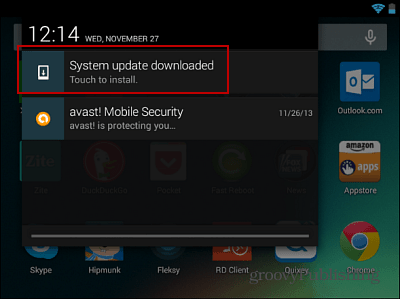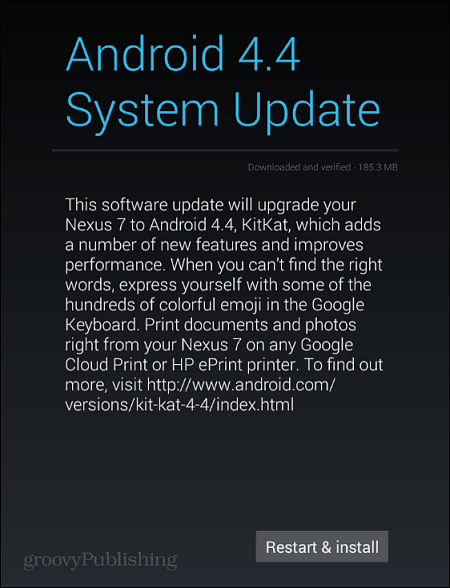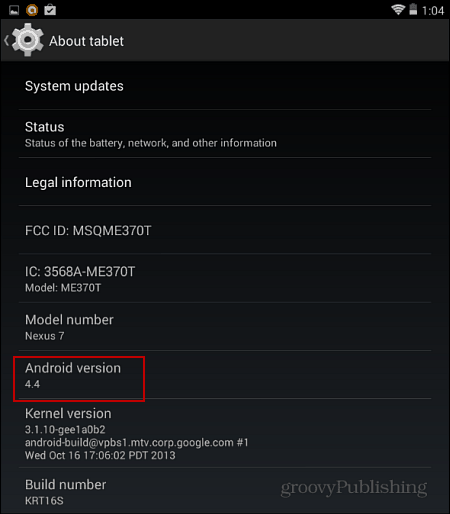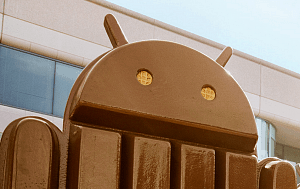Google announced that it was rolling out its updated version of Android – 4.4 KitKat – for the Nexus line of products earlier this month. But it certainly took quite a while from the announcement to get it, for me anyway. Yesterday I finally found that it was available to install as an over-the-air upgrade. Here’s a look at the simple update process and what’s new.
Update to Android 4.4
When it’s ready, you’ll see the notifications that it has been downloaded and is ready to install. The file size is 185 MB which is easily manageable over a WiFi connection.

After tapping the notification you’ll get the following message about the update.

When it comes back from the reboot, you’ll notice some of the icons and look of the interface is a bit different. Tap the shiny new gear icon for Settings then scroll down to About Tablet. On the next screen you’ll see your device is now running Android version 4.4.

Now you can start playing around with the new features in KitKat which include:
- Saying “Okay Google” will now activate Google Search from anywhere on the Home Screen or in Google Now. This does not function while the phone is locked or in other apps X unless the phone specifically has built-in support for it like the Moto X does.
- Will run on phones with as little as 512MB RAM.
- Core system apps now use less memory and attempt to protect against memory leaks from other apps.
- Massively reduced power consumption with audio tunneling to DSP. Provides up to 60 hours of audio playback.
- App Management now includes information about how much RAM each individual app uses over time.
- Emoji icons are embedded in the keyboard.
- New support for printers allowing more compatibility with more devices, this is mostly done through a whole new printing API that will make it much easier for printer manufacturers to develop streamlined apps.
- New support for screen recording (like screenshots, but video).
- Quickoffice ships built-in with Android.
- Better multi-tasking.
- New downloads app, complete revamp.
- New built-in email app, the old one was redone.
- Caller ID performs a Google search for unknown callers to attempt to display information on who the number belongs to.
- Google is fragmenting the operating system so each section is an individual component that runs as an app. This will make the new features available faster since future phone swill not have to wait for complete operating system updates. This is in direct response to complaints about phone carriers being too slow to release updates. It also in effect will kill TouchWiz, Sense, and other garbage manufacturer-specific UIs. Arstechnia has an in-depth article about how this affects the interface.
- Like the iPhone, music and movie playback can now be completely controlled from the lock-screen.
- Major improvements to NFC payments.
- New “Moves” app counts steps – one example use is for exercise.
- Full-screen wallpapers
- Smart-sensor monitoring prevents certain sensors from getting stuck on and wasting power.
- Built-in infrared control support.
- Optional text-messaging integration with Google Hangouts.
- More search functionality for Google Apps Contacts users.
- Full-screen mode for games, movies, and books.
- Overall performance improvement across touch, processing, power consumption, and device management.
- Apps now run within sandboxes so security vulnerabilities shouldn’t bring down the whole system.
Have you updated to the new Android version? If so, leave a comment and tell us what you’re favorite tips and tricks are!







